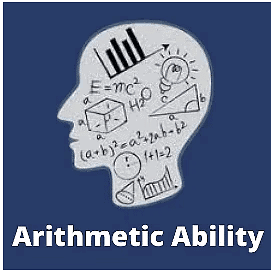Cheatsheet: Arithmetic Ability | IBPS PO Prelims & Mains Preparation - Bank Exams PDF Download
| Table of contents |

|
| Theory |

|
| Tips |

|
| Formula |

|
| Solved Example |

|
Theory
Arithmetic Ability is a crucial part of the Quant section in Banking Entrance exams. Understanding the fundamentals and formulas is essential for solving problems accurately and quickly. A solid grasp of basic operations, percentages, fractions, ratios, and time-related problems will greatly enhance problem-solving efficiency.
Tips
The order of division and multiplication can be interchanged. Similarly, the order of addition and subtraction can be interchanged.
For fractions, find a common denominator when adding or subtracting, and use reciprocals when dividing.
For time and work problems, the combined work is calculated using the formula 1 / (1/x + 1/y).
In percentage problems, always express the part and whole clearly before calculating.
Formula
Basic Operations
Addition: Combine numbers to get a total.
Subtraction: Find the difference between two numbers.
Multiplication: Repeated addition of a number.
Division: Splitting a number into equal parts.
Percentages
Formula:
Percentage = (Part/Whole) × 100To Find Percentage of a number:
Percentage of number = (Percentage × Number) ÷ 100Increase/Decrease:
New Value = Original Value ± (Percentage × Original Value) ÷ 100
Fractions
Addition/Subtraction: Find a common denominator and then add or subtract the numerators.
Multiplication: Multiply numerators together and denominators together.
Division: Multiply by the reciprocal of the second fraction.
Averages
Formula:
Average = (Sum of all values) ÷ (Number of values)To find the Average Speed:
Average Speed = Total Distance ÷ Total Time
Speed, Time, and Distance
Formula:
Speed = Distance ÷ Time
Time = Distance ÷ Speed
Distance = Speed × TimeUnits:
Distance = Kilometers (km), Time = Hours (hr), Speed = Kilometers per hour (km/h)
Profit and Loss
Profit:
Profit = Selling Price (SP) - Cost Price (CP)Loss:
Loss = Cost Price (CP) - Selling Price (SP)Profit Percentage:
Profit Percentage = (Profit ÷ Cost Price) × 100Loss Percentage:
Loss Percentage = (Loss ÷ Cost Price) × 100
Simple Interest
Formula:
SI = (Principal × Rate × Time) ÷ 100Amount (A):
Amount = Principal + Simple Interest
Compound Interest
Formula:
Amount = P (1 + r/n)^(nt)P = Principal,
r = Rate of interest,
n = Number of times interest is compounded per year,
t = Time in years
Compound Interest (CI) = Amount - Principal
Ratio and Proportion
Ratio: Expresses a relationship between two quantities.
Proportion: An equation stating that two ratios are equal.
Formula for Direct Proportion:
a/b = c/d → a × d = b × cFormula for Inverse Proportion:
a × b = c × d
Partnership
Profit Sharing:
Profit Share = (Investment of Partner) ÷ (Total Investment)
Algebraic Formulas
(a + b)² = a² + 2ab + b²
(a - b)² = a² - 2ab + b²
(a + b)(a - b) = a² - b²
Work and Time
Formula:
Work = Rate × TimeIf A can do a job in x days, and B in y days, the combined work is done in:
1/(1/x + 1/y) days
Mixtures and Alligations
Alligation Formula:
(Cost Price of First Item - Mean Price) / (Mean Price - Cost Price of Second Item)
Time and Work
If A completes a task in x days and B completes it in y days, the time taken by A and B together is:
(x × y) / (x + y)
Solved Example
|
647 videos|1000 docs|305 tests
|
FAQs on Cheatsheet: Arithmetic Ability - IBPS PO Prelims & Mains Preparation - Bank Exams
| 1. What are arithmetic abilities in banking exams? |  |
| 2. How important is arithmetic ability in banking exams? |  |
| 3. What are some common arithmetic topics tested in banking exams? |  |
| 4. How can I improve my arithmetic ability for banking exams? |  |
| 5. Are there any online resources available for improving arithmetic ability for banking exams? |  |















